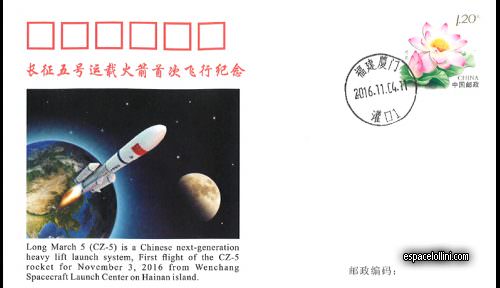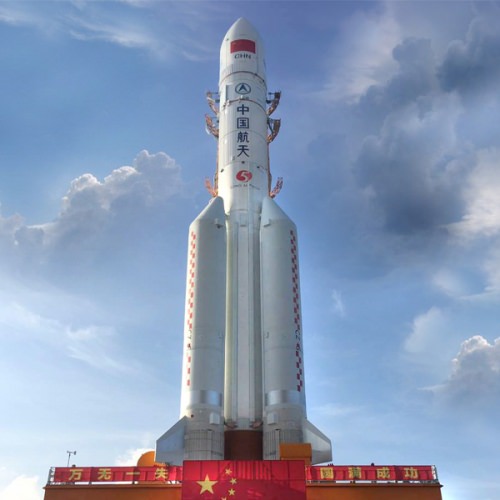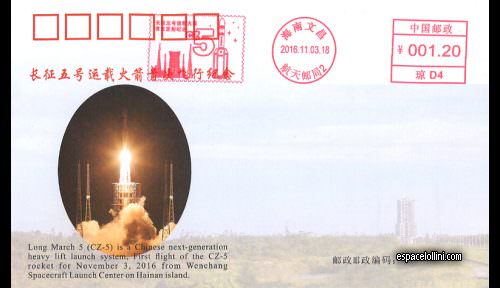Here are details about a :
Space commemorative cover
or Space Cover.
Cosmodrome / Location : China
Date of Cancellation: Nov. 3, 2016
Exist : 200 copies
Event Type : Launch
Launch Pad / Location : China Wenchang
Manned / Robotic Mission : Robotic
Mission Objective/Type : Base / Launcher
ou?/where?: au sol - ground
autographe?: non - noneDescription : On November 3, the CZ-5 launched its maiden flight from the Wenchang Space Center. Consisting of a central body and 4 boosters, the CZ-5 shows slightly better performance than Ariane 5.
In southwestern China, Hainan Island was chosen several years ago to host the new Wenchang Space Center, which demonstrates the country`s desire to increase its autonomy in access to the Earth`s orbit, For manned flights and missions to explore the solar system. Wenchang was first launched on June 25 with the inaugural flight of the CZ-7 launcher. And on November 3rd, it was again an inaugural flight from there, but this time for an even more powerful launcher, the CZ-5 (Chang Zheng 5 or Long March 5).
CZ-5: a launcher for Mars and the future Chinese station
Despite what the figures 7 and 5 may suggest, the CZ-5 is more powerful than the CZ-7. The video below shows its take-off at night on November 3rd.
Gradually, CNSA, the Chinese space agency, is completely renewing its range of launchers, moving to more advanced technologies such as kerosene and liquid oxygen or hydrogen and oxygen (liquid or powder) engines. Pollutant propellants such as those based on hydrazine are deserted except when they are essential, for example for certain upper floors.
For the CZ-5, the first stage is powered by two YF-77 engines that consume hydrogen and liquid oxygen (like the Ariane 5 Vulcain 2). It is assisted by 4 boosters each equipped with 2 YF-100 engines that use kerosene and liquid oxygen. The second stage uses liquid hydrogen and oxygen for its 2 YF-75D engines.
With the inaugural flight of the CZ-5, China has a heavy launcher in the same category as the European Ariane 5. Indeed, a CZ-5 has an announced performance of 23 tons in low orbit and 13 tons for the geostationary transfer orbit (respectively 20 and 10.5 tons for Ariane 5). For its 3 November mission, the CZ-5 placed an upper YZ-2 stage on orbit with a Shijian satellite 17 to test an electric-type propulsion.
While the CZ-5 can be used for several types of missions, the 23-tonne low-orbit system allows the sending of modules from the future large Chinese station for the early 2020s. Unlike Tiangong-1 and Tiangong-2 Which consist of only one module, Tiangong-3 will consist of several modules like the old Russian station Mir or the current International Space Station (in size, it will moreover be closer to Mir ). The performance of the CZ-5 is also in line with what is required to send Mars to a rover that would move to the surface of the red planet, an ambition displayed by China. Keyword(s) :
#Rocket,
#Satellite,
#Telecommunications, SPACE REVUE : 06 - 2017 Last modified: 06/05/2017 @ 12h05
| Add to cart |
SEE ALSO  |
 |
  |
CHINE 601 L | 18,- |
| |
item shown here with picture. |
| |
items related to the item shown. |
|
 See My Cart See My Cart |
|
|

Space Event : CZ 5 LANCEUR · SHIJIAN 17 SATELLITE

CHINE 601
|